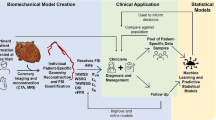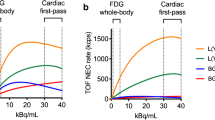Abstract
Spatial heterogeneity of myocardial perfusion has been recognized for many years. Whether this is primarily the result of heterogeneity of parameters such as myocardial metabolism, of intramyocardial mechanical forces, or of vasomotor function within the myocardial microcirculation, is not clear. A practical problem is that it has been almost impossible to measure any two of these parameters simultaneously in the same piece of myocardium so that an unambiguous correlation, much less a cause-and-effect relationship, has been difficult to establish. In this study of six anesthetized pigs, we propose that whole-body computed tomography is a method for providing the simultaneous measurement of heterogeneity of myocardial perfusion (F) and myocardial blood volume (ρ). The first finding was that the empirical relationship ρ=AF+BF0.5 between myocardial blood flow (F) and intramyocardial blood volume (ρ) is maintained over a range of sizes of regions of interest (approximately 1 to 0.125 cm3) within the myocardium of each individual animal despite the spatial heterogeneity of the F and the ρ values. The value of A ranges from 0.014 to 0.021 min and of B ranges from 0.061 to 0.076 ml0.5 g−0.5 min0.5. A second finding was that the pattern of spatial heterogeneity of F and of ρ remained reasonably stable over at least a 1 h period. © 1998 Biomedical Engineering Society.
PAC98: 8745Ft, 8759Fm
Similar content being viewed by others
REFERENCES
Bassingthwaighte, J. B., R. B. King, and S. A. Roger. Fractal nature of regional myocardial blood flow heterogeneity. Circ. Res.65:578-590, 1989.
Behrenbeck, T., J. H. Kinsey, L. D. Harris, R. A. Robb, and E. L. Ritman. Three-dimensional spatial, density, and temporal resolution of the dynamic spatial reconstructor. J. Comput. Assist. Tomogr.6:1138-1147, 1982.
Chesler, D. A., S. J. Riederer, and N. J. Pelc. Noise due to photon counting statistics in computed tomography. J. Comput. Assist. Tomogr.1:64-74, 1977.
Falsetti, H. L., R. J. Carroll, and M. L. Marcus. Temporal heterogeneity of myocardial blood flow in anesthetized dogs. Circulation52:848-853, 1975.
Feigl, E. O. Coronary physiology. Physiol. Rev.63:1-205, 1983.
Franzen, D., R. S. Conway, H. Zhang, E. H. Sonnenblick, and C. Eng. Spatial heterogeneity of local blood flow and metabolite content in dog hearts. Am. J. Physiol.254:H344- H353, 1988.
Gonzalez, F., and J. B. Bassingthwaighte. Heterogeneities in regional volumes of distribution and flows in rabbit heart. Am. J. Physiol.258:H1012-H1024, 1990.
Iversen, P. O. Evidence for long term fluctuation in regional blood flow within the rabbit left ventricle. Acta Physiol. Scand.146:329-339, 1992.
Iversen, P. O., and G. Nicolaysen. Fractals describe blood flow heterogeneity with skeletal muscle and with myocardium. Am. J. Physiol.268:H112-H116, 1995.
Jorgensen, S. M., S. V. Whitlock, P. J. Thomas, R. W. Roessler, and E. L. Ritman. The dynamic spatial reconstructor: A high speed, stop action, 3-D, digital radiographic imager of moving internal organs and blood. Proc. SPIE1346:180-191, 1990.
Katz, A. M., and P. B. Katz. Homogeneity out of heterogeneity. Circulation79:712-717, 1989.
King, R. B., and J. B. Bassingthwaighte. Temporal fluctuations in regional myocardial flows. Pflugers Arch.413:336- 342, 1989.
King, R. B., L. J. Weissman, and J. B. Bassingthwaighte. Fractal description for spatial statistics. Ann. Biomed. Eng.18:111-121, 1990.
Kuo, L., W. M. Chilian, and M. J. Davis. Interaction of pressure-and flow-induced responses in porcine coronary resistance vessels. Am. J. Physiol.261:H1706-H1715, 1991.
Liu, Y., R. C. Bahn, E. L. Ritman, and P. E. Beighley. Microvascular blood volume-to-flow relationships in porcine heart wall: Whole body CT evaluation in vivo. Am. J. Physiol.269:H1820-H1826, 1995.
Matsumoto, T., M. Goto, H. Tachibana, Y. Ogasawara, K. Tsujioka, and F. Kajiya. Microheterogeneity of myocardial blood flow in rabbit hearts during normoxic and hypoxic states. Am. J. Physiol.270:H435-H441, 1996.
Mori, H., M. Chujo, S. Haruyama, H. Sakamato, Y. Shinozaki, M. Uddin-Mohammed, A. Iida, and H. Nakazawa. Local continuity of myocardial blood flow studied by monochromatic synchrotron radiation-Excited x-ray fluorescence spectrometry. Circ. Res.76:1008-1100, 1995.
Potter, R. F., and A. C. Groom. Capillary diameter and geometry in cardiac and skeletal muscle studied by means of corrosion casts. Microvasc. Res.25:68-84, 1983.
Pries, A. R., T. W. Secomb, and P. Gaehtgens. Structure and hemodynamics of microvascular networks: Heterogeneity and correlations. Am. J. Physiol.209:H1713-H1722, 1995.
Pries, A. R., T. W. Secomb, and P. Gaehtgens. Relationship between structural and hemodynamic heterogeneity in microvascular networks. Am. J. Physiol.270:H545-H533, 1996.
Ritman, E. L. Computed tomography evaluation of regional increases in microvascular permeability after reperfusion of locally ischemic myocardium in intact pigs. Acad. Radiol.2:952-958, 1995.
Sestier, F. J., R. R. Kieldenterger, and G. A. Klassen. Role of autoregulation in spatial and temporal perfusion heterogeneity of canine myocardium. Am. J. Physiol.235:H64-H71, 1978.
Shu, N., and E. L. Ritman. Heterogeneity of intramyocardial blood flow, blood volume and transit time-fractal analysis of fast CT images. Physiologist32:188, 1989.
Van Bavel, E., and J. A. E. Spaan. Branching patterns in the porcine coronary arterial tree. Estimation of flow heterogeneity. Circ. Res.71:1200-1212, 1992.
van Beek, J. H., S. A. Roger, and J. B. Bassingthwaighte. Regional myocardial flow heterogeneity explained with fractal networks. Am. J. Physiol.257:H1670-H1680, 1989.
Wang, T., X. Wu, N. Chung, and E. L. Ritman. Myocardial blood flow estimated by synchronous, multislice, high-speed computed tomography. IEEE Trans. Med. Imaging8:70-77, 1989.
Wolpers, H. G., A. Hoeft, H. Korb, P. R. Lichtlen, and G. Helliji. Heterogeneity of myocardial blood flow under normal conditions and its dependance on arterial PO2. Am. J. Physiol.258:H549-H555, 1990.
Wu, X. S., D. L. Ewert, Y. H. Liu, and E. L. Ritman. In vivorelation of intramyocardial blood volume to myocardial perfusion: Evidence supporting microvascular site for autoregulation. Circulation85:730-737, 1992.
Author information
Authors and Affiliations
Rights and permissions
About this article
Cite this article
Ritman, E.L. Temporospatial Heterogeneity of Myocardial Perfusion and Blood Volume in the Porcine Heart Wall. Annals of Biomedical Engineering 26, 519–525 (1998). https://doi.org/10.1114/1.98
Issue Date:
DOI: https://doi.org/10.1114/1.98




